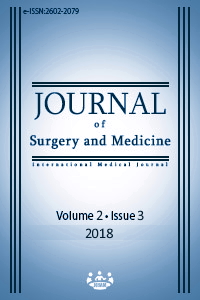The effect of CPAP during preoxygenation and PEEP during induction upon the duration of non-hypoxic apnea and hemodynamic parameters
Keywords:
CPAP, PEEP, Non-hypoxic apnea, PreoxygenationAbstract
Aim: This study evaluated the effects of applying CPAP during preoxygenation and PEEP during mask ventilation upon the duration of non-hypoxic apnea and hemodynamic parameters.
Methods: This prospective randomized study included 100 patients allocated to 4 groups. In Groups I and III, preoxygenation was applied with CPAP mask without any pressure and during induction ventilation was performed with volume-controlled ventilation (CMV) in Group I and CMV + 6 cm H2O PEEP in Group III. In Groups II and IV, preoxygenation was applied with CPAP mask with 6 cmH2O pressure and during induction; ventilation was performed with CMV in Group II and CMV + 6 cm H2O PEEP in Group IV. After tracheal intubation, the tube was left open to air and the patient remained apneic until SpO2 reached 90%.
Results: The time for SpO2 to reach 90% is significantly longer in Group IV compared to the other groups. The durations were 412.50±97.37 sec in Group I, 443.52±88.84 sec in Group II, 415.20±117.45 sec in Group III and 522.92±83.44 sec in Group IV. Using only CPAP during preoxygenation and only PEEP during mask ventilation had no significant effect on duration of non-hypoxic apnea.
Conclusion: Especially for patients with difficult intubation, application of CPAP during preoxygenation followed with PEEP during mask ventilation safe, simple and it prolongs non-hypoxic apnea period.
Downloads
References
Lumb AB. Oxygen. Nunn’s Applied Respiratory Physiology Oxford: Butterworth-Heinmann 2000;288-290.
Edmark L, Enlund M, Kostova-Aherdan K, Hedenstierna G. Atelectasis formation and apnoea tolerance after pre-oxygenation with 100%, 80%, or 60% oxygen. Anesthesiology. 2001;95:A1330.
Lundquist H, Hedenstierna G, Strandberg A, Tokics L, Brismar B. CT-assessment of dependent lung densities in man during general anaesthesia. Acta Radiologica. 1995;36:626–32.
Magnusson L, Spahn DR. New concepts of atelectasis during general anaesthesia. British Journal of Anaesthesia. 2003;91:61–72.
Rothen HU, Sporre B, Engberg G, Wegenius G, Reber A, Hedenstierna G. Prevention of atelectasis during general anaesthesia. Lancet. 1995;345:1387–91.
Joyce CJ, Wıllıams AB. Kinetics of absorption atelectasis during anesthesia: a mathematical model. J Appl Physiol. 1999;86:1116-25.
Rusca M, Wicky S, Proietti S. Continuous positive airways pressure prevents atelectasis formation during induction of general anaesthesia. Anesthesiology. 2001;95:AI33I.
Rusca M, Proietti S, Schnyder P, Frascarolo P, Hedenstierna G, Spahn DR, Magnusson L. Prevention of atelectasis formation during induction of general anesthesia. Anesthesia & Analgesia. 2003;97:1835–9.
Herriger A, Frascarolo Ph, Spahn DR, Magnusson L. The effect of positive airway pressure during pre-oxygenation and induction of anaesthesia upon duration of non-hypoxic apnoea. Anaesthesia. 2004;59:243–47.
Gander S, Frascarolo P, Suter M, Spahn D.R, Magnusson L. Positive end-expiratory pressure during induction of general anesthesia increases duration of nonhypoxic apnea in morbidly obese patients. Anesth Analg. 2005;100:580–4
Hedenstierna G, Tokics L, Strandberg A, Lundquist H, Brismar B. Correlation of gas exchange impairment to development of atelectasis during anaesthesia and muscle paralysis. Ada Anaesthesiol Scand. 1986;30:183-91.
Nunn JF. Factors influencing the arterial oxygen tension during halothane anaesthesia with spontaneous respiration. British Journal of Anaesthesia. 1964;36:327–41.
Bendixen HH, Hedley-White J, Laver MB. Impaired oxygenation in surgical patients during general anesthesia with controlled ventilation. A concept of atelectasis. N Engl J Med. 1963;269:991-6
Nyman G, Funkquist B, Kvart C, et al. Atelectasis causes gas exchange impairment in the anaesthetised horse. Equine Vet J. 1990;22:317-24.
Duggan M, Kavanagh BP. Pulmonary Atelectasis A Pathogenic Perioperative Entity Anesthesiology. 2005;102:838–54.
Reber A, Engberg G, Wegenius G, Hedenstierna G. Lung aeration. The effect of pre-oxygenation and hyperoxygenation during total intravenous anaesthesia. Anaesthesia. 1996;51:733-7.
Baraka A. Routine preoxygenation. Anesthesia. 2006;61:612-3.
Kung MC, Hung CT, Ng KP. Arterial desaturation during induction in healty adults: should preoxygenation be a routine? Anesth Intens Care. 1991;19:192-6.
Bell MDD. Routine preoxygenation- a new ‘minimum standard of care’. Anaesthesia. 2004;59:943–5.
Saunders RA, Milner AD, Hopkins IE. The effects of CPAP on lung mechanics and lung volumes in the neonate. Biol Neonate. 1976;29:178-84.
Ahumada CA, Goldsmith JP. Continuous Distending pressure. In: Goldsmith JP, Karotkin EH, editors. Philadelphia: Assisted Ventilation of the Neonate. WB Saunders: p. 151-166.
Lawson EE, Birdwell RL, Huang PS. Augmentation of pulmonary surfactant secretion by lung expansion at birth. Pediatr Res. 1979;13:611-4.
Benumof J. Preoxygenation: best method for both efficacy and efficiency. Anesthesiology. 1999;9:603–5.
Reynolds S, Heffner J. Airway management of the critically ill patient: rapid-sequence intubation. Chest. 2005;127:1397–412.
Venkateswaran R, Goneppanavar U, Frenny AP. Preoxygenation with 208 head-up tilt provides longer duration of non-hypoxic apnea than conventional preoxygenationin non-obese healthy adults. J Anesth. 2011;25:189–94.
Cressey DM, Berthoud M. C, Reilly CS. Effectiveness of continuous positive airway pressure to enhance pre-oxygenation in morbidly obese women. Anaesthesia. 2001;56:670-689.
Xue FS, Huang YG, Tong SY, et al. A comparative study of early postoperative hypoxemia in infants, children, and adults undergoing elective plastic surgery. Anesth Analg. 1996;83:709-15.
Rothen HU, Sporre B, Engberg G,Wegenius G, Hedenstierna G. Re-expansion of atelectasis during general anesthesia: A computed tomography study. Br J Anaesth. 1993;71:788-95.
Tusman G, Böhm SH, Vazquez de Anda GF, Campo JL, Lachmann B. Alveolar recruitment strategy improves arterial oxygenation during general anesthesia. BJA. 1999;82(1):8-13.
Neumann P, Rothen HU, Berglund JE, Valtysson J, Magnusson A, Hedenstıerna G. Positive end-expiratory pressure prevents atelectasis during general anaesthesia even in the presence of a high inspired oxygen concentration. Acta Anaesthesiol Scand. 1999;43:295–301.
Downloads
- 1597 2342
Published
Issue
Section
How to Cite
License
Copyright (c) 2018 Havva Esra Uyar Türkyılmaz, Asutay Göktuğ, Selçuk Tur, Hülya Başar
This work is licensed under a Creative Commons Attribution-NonCommercial-NoDerivatives 4.0 International License.















